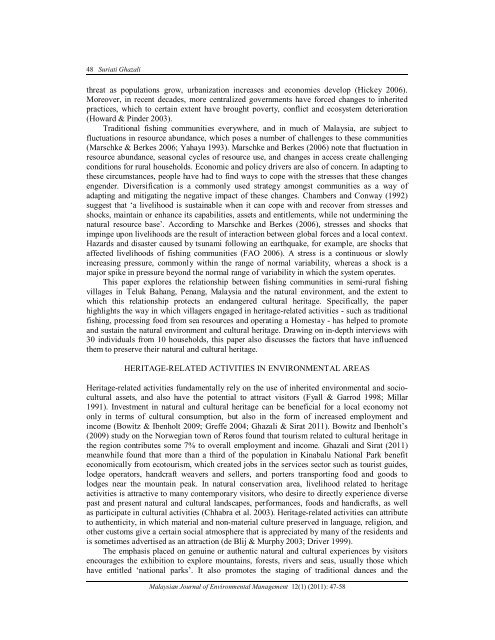Safeguarding Natural and Cultural Heritage - Malaysia Journal of ...
Safeguarding Natural and Cultural Heritage - Malaysia Journal of ...
Safeguarding Natural and Cultural Heritage - Malaysia Journal of ...
You also want an ePaper? Increase the reach of your titles
YUMPU automatically turns print PDFs into web optimized ePapers that Google loves.
48 Suriati Ghazali<br />
threat as populations grow, urbanization increases <strong>and</strong> economies develop (Hickey 2006).<br />
Moreover, in recent decades, more centralized governments have forced changes to inherited<br />
practices, which to certain extent have brought poverty, conflict <strong>and</strong> ecosystem deterioration<br />
(Howard & Pinder 2003).<br />
Traditional fishing communities everywhere, <strong>and</strong> in much <strong>of</strong> <strong>Malaysia</strong>, are subject to<br />
fluctuations in resource abundance, which poses a number <strong>of</strong> challenges to these communities<br />
(Marschke & Berkes 2006; Yahaya 1993). Marschke <strong>and</strong> Berkes (2006) note that fluctuation in<br />
resource abundance, seasonal cycles <strong>of</strong> resource use, <strong>and</strong> changes in access create challenging<br />
conditions for rural households. Economic <strong>and</strong> policy drivers are also <strong>of</strong> concern. In adapting to<br />
these circumstances, people have had to find ways to cope with the stresses that these changes<br />
engender. Diversification is a commonly used strategy amongst communities as a way <strong>of</strong><br />
adapting <strong>and</strong> mitigating the negative impact <strong>of</strong> these changes. Chambers <strong>and</strong> Conway (1992)<br />
suggest that ‘a livelihood is sustainable when it can cope with <strong>and</strong> recover from stresses <strong>and</strong><br />
shocks, maintain or enhance its capabilities, assets <strong>and</strong> entitlements, while not undermining the<br />
natural resource base’. According to Marschke <strong>and</strong> Berkes (2006), stresses <strong>and</strong> shocks that<br />
impinge upon livelihoods are the result <strong>of</strong> interaction between global forces <strong>and</strong> a local context.<br />
Hazards <strong>and</strong> disaster caused by tsunami following an earthquake, for example, are shocks that<br />
affected livelihoods <strong>of</strong> fishing communities (FAO 2006). A stress is a continuous or slowly<br />
increasing pressure, commonly within the range <strong>of</strong> normal variability, whereas a shock is a<br />
major spike in pressure beyond the normal range <strong>of</strong> variability in which the system operates.<br />
This paper explores the relationship between fishing communities in semi-rural fishing<br />
villages in Teluk Bahang, Penang, <strong>Malaysia</strong> <strong>and</strong> the natural environment, <strong>and</strong> the extent to<br />
which this relationship protects an endangered cultural heritage. Specifically, the paper<br />
highlights the way in which villagers engaged in heritage-related activities - such as traditional<br />
fishing, processing food from sea resources <strong>and</strong> operating a Homestay - has helped to promote<br />
<strong>and</strong> sustain the natural environment <strong>and</strong> cultural heritage. Drawing on in-depth interviews with<br />
30 individuals from 10 households, this paper also discusses the factors that have influenced<br />
them to preserve their natural <strong>and</strong> cultural heritage.<br />
HERITAGE-RELATED ACTIVITIES IN ENVIRONMENTAL AREAS<br />
<strong>Heritage</strong>-related activities fundamentally rely on the use <strong>of</strong> inherited environmental <strong>and</strong> sociocultural<br />
assets, <strong>and</strong> also have the potential to attract visitors (Fyall & Garrod 1998; Millar<br />
1991). Investment in natural <strong>and</strong> cultural heritage can be beneficial for a local economy not<br />
only in terms <strong>of</strong> cultural consumption, but also in the form <strong>of</strong> increased employment <strong>and</strong><br />
income (Bowitz & Ibenholt 2009; Greffe 2004; Ghazali & Sirat 2011). Bowitz <strong>and</strong> Ibenholt’s<br />
(2009) study on the Norwegian town <strong>of</strong> Røros found that tourism related to cultural heritage in<br />
the region contributes some 7% to overall employment <strong>and</strong> income. Ghazali <strong>and</strong> Sirat (2011)<br />
meanwhile found that more than a third <strong>of</strong> the population in Kinabalu National Park benefit<br />
economically from ecotourism, which created jobs in the services sector such as tourist guides,<br />
lodge operators, h<strong>and</strong>craft weavers <strong>and</strong> sellers, <strong>and</strong> porters transporting food <strong>and</strong> goods to<br />
lodges near the mountain peak. In natural conservation area, livelihood related to heritage<br />
activities is attractive to many contemporary visitors, who desire to directly experience diverse<br />
past <strong>and</strong> present natural <strong>and</strong> cultural l<strong>and</strong>scapes, performances, foods <strong>and</strong> h<strong>and</strong>icrafts, as well<br />
as participate in cultural activities (Chhabra et al. 2003). <strong>Heritage</strong>-related activities can attribute<br />
to authenticity, in which material <strong>and</strong> non-material culture preserved in language, religion, <strong>and</strong><br />
other customs give a certain social atmosphere that is appreciated by many <strong>of</strong> the residents <strong>and</strong><br />
is sometimes advertised as an attraction (de Blij & Murphy 2003; Driver 1999).<br />
The emphasis placed on genuine or authentic natural <strong>and</strong> cultural experiences by visitors<br />
encourages the exhibition to explore mountains, forests, rivers <strong>and</strong> seas, usually those which<br />
have entitled ‘national parks’. It also promotes the staging <strong>of</strong> traditional dances <strong>and</strong> the<br />
<strong>Malaysia</strong>n <strong>Journal</strong> <strong>of</strong> Environmental Management 12(1) (2011): 47-58


